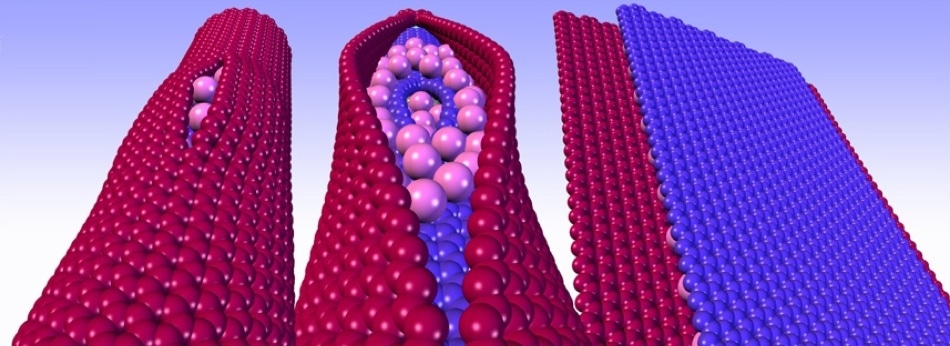Sep 20 2016
 Rice University researchers James Tour, left, and William Sikkema. (Credit: Jeff Fitlow/Rice University)
Rice University researchers James Tour, left, and William Sikkema. (Credit: Jeff Fitlow/Rice University)
James Tour, a chemist at Rice University, stated that a treatment procedure to heal damaged spinal cords by combining graphene nanoribbons produced with a process invented at Rice and a common polymer is expected to gain importance.
As stated in an issue of Nature from 2009, chemists at the Tour lab started their research work with the discovery of a chemical process to unravel graphene nanoribbons from the multiwalled carbon nanotubes, and have been working with graphene nanoribbons for almost 10 years now.
Since then, the researchers have been using nanoribbons to produce better batteries, and improve materials for things such as, deicers for airplane wings and less-permeable containers that can store natural gas.
The recent research work by Rice University scientists has resulted in medical applications of nanoribbons. A material dubbed Texas-PEG has been developed that will help to treat damaged spinal cords or even knit severed spinal cords.
A paper describing the results of preliminary animal-model tests has been published in the current issue of the journal Surgical Neurology International.
William Sikkema, a Rice graduate student and also a co-lead author of the paper has customized these graphene nanoribbons for use in the medical domain. This customized nanoribbon is highly soluble in polyethylene glycol (PEG), which is a biocompatible polymer gel that is generally used in pharmaceutical products, surgeries, and other biological applications.
While mixing biocompatible nanoribbons with PEG after the edges of these biocompatible nanoribbons are functionalized with PEG chains, an electrically active network that helps the damaged spinal cord to reconnect.
“Neurons grow nicely on graphene because it’s a conductive surface and it stimulates neuronal growth,” Tour said.
When studies were conducted at Rice University and at other places, it was observed that the neurons grew along with graphene.
We’re not the only lab that has demonstrated neurons growing on graphene in a petri dish. The difference is other labs are commonly experimenting with water-soluble graphene oxide, which is far less conductive than graphene, or nonribbonized structures of graphene. We’ve developed a way to add water-solubilizing polymer chains to the edges of our nanoribbons that preserves their conductivity while rendering them soluble, and we’re just now starting to see the potential for this in biomedical applications.
Jame Tour, Chemist, Rice University
He also stated that ribbonized graphene structures allow smaller amounts to be utilized to preserve a conductive pathway to bridge the severed spinal cord. Tour explained that only 1% of Texas-PEG comprises of nanoribbons, and that is enough to build a conductive scaffold where the spinal cord can reconnect.
Co-authors Bae Hwan Lee and C-Yoon Kim conducted an experiment at Konkuk University in South Korea, and observed that Texas-PEG was successfully able to restore function in a rodent that had a severed spinal cord. Tour explained that the material provided reliable motor and sensory neuronal signals to pass through the gap for 24 hours after total transection of the spinal cord and nearly perfect motor control recovery after 14 days.
This is a major advance over previous work with PEG alone, which gave no recovery of sensory neuronal signals over the same period of time and only 10 percent motor control over four weeks.
Jame Tour, Chemist, Rice University
The seed to start this project began when Sikkema came across a study undertaken by Italian neurosurgeon Sergio Canavero. Sikkema expected nanoribbons to enhance the research work that was based on PEG’s ability to promote the fusion of cell membranes by adding directional control for neurons and electrical conductivity while they spanned the gap between sections of the spinal cord. Developing contacts with the doctor resulted in a tie up with the South Korean researchers.
Tour told that Texas-PEG’s ability to help patients having spinal cord injuries is too reliable to be ignored. “Our goal is to develop this as a way to address spinal cord injury. We think we’re on the right path,” he said.
This is an exciting neurophysiological analysis following complete severance of a spinal cord. It is not a behavioral or locomotive study of the subsequent repair. The tangential singular locomotive analysis here is an intriguing marker, but it is not in a statistically significant set of animals. The next phases of the study will highlight the locomotive and behavioral skills with statistical relevance to assess whether these qualities follow the favorable neurophysiology that we recorded here.
Jame Tour, Chemist, Rice University
Kim, co-primary author of the paper, is a research professor in the Department of Stem Cell Biology, School of Medicine, Konkuk University, Seoul, South Korea, and a researcher at Seoul National University. Lee is an associate professor of physiology at the Yonsei University College of Medicine, Seoul. Tour is the T.T. and W.F. Chao Professor of Chemistry as well as a professor of computer science and of materials science and nanoengineering. Co-authors are In-Kyu Hwang of Konkuk University, Hanseul Oh of Seoul National University and Un Jeng Kim of the Yonsei University College of Medicine.